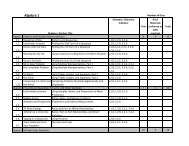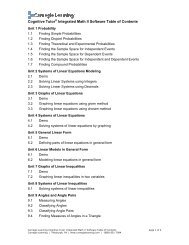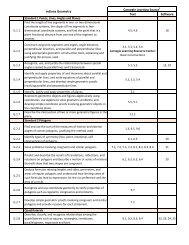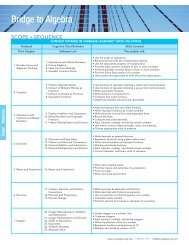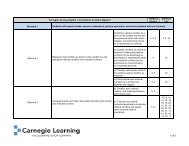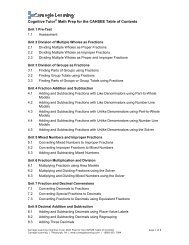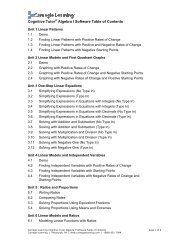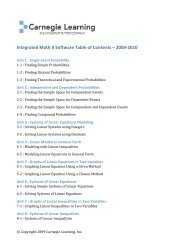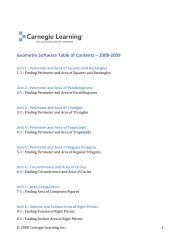GEOMETRY - Carnegie Learning
GEOMETRY - Carnegie Learning
GEOMETRY - Carnegie Learning
You also want an ePaper? Increase the reach of your titles
YUMPU automatically turns print PDFs into web optimized ePapers that Google loves.
<strong>GEOMETRY</strong>Student Text© 2008 <strong>Carnegie</strong> <strong>Learning</strong>, Inc.
Pittsburgh, PAPhone 888.851.7094Fax 412.690.2444www.carnegielearning.comAcknowledgmentsWe would like to thank those listed below who helpedto prepare the Cognitive Tutor ® Geometry Student Text.William S. HadleyJessica PfluegerJaclyn SnyderMichele CovattoThe <strong>Carnegie</strong> <strong>Learning</strong> Development TeamGeometry was used to design the archways that form the tunnel on the front cover.The perspective of the photograph is very interesting. It appears as though the archwayscontinue to get smaller as you go through the tunnel. Actually, each archway is the same size.This is because a three-dimensional object, the tunnel, is being represented on a twodimensionalsurface, the cover of this book. Each archway is a half of a circle, or a semicircle.To design the tunnel, architects used the formula for the circumference of a semicircle, which isthe formula shown on the cover. As you work through the Cognitive Tutor ® Geometry text andsoftware, you will see additional opportunities for using Geometry in your everyday activities.Copyright © 2008 by <strong>Carnegie</strong> <strong>Learning</strong>, Inc. All rights reserved. <strong>Carnegie</strong> <strong>Learning</strong>,Cognitive Tutor, SchoolCare, and <strong>Learning</strong> by Doing are all registered marks of <strong>Carnegie</strong><strong>Learning</strong>, Inc. All other company and product names mentioned are used for identificationpurposes only and may be trademarks of their respective owners. This product or portionsthereof is manufactured under license form <strong>Carnegie</strong> Mellon University. Permission is grantedfor photocopying rights within licensed sites only. Any other usage or reproduction in anyform is prohibited without the express consent of the publisher.ISBN-13 978-1-932409-68-0ISBN-10 1-932409-68-8Student Text© 2008 <strong>Carnegie</strong> <strong>Learning</strong>, Inc.Printed in the United States of America1-2006-VH2-2006-VH3-2006-VH4-2007-VH5-2007-VH6-4/2008-HPS
Dear Student,You are about to begin an exciting adventure using mathematics, the languageof science and technology. As you sit in front of a computer screen or videogame, ride in an automobile, fly in a plane, talk on a cellular phone, or use anyof the tools of modern society, realize that mathematics was critical in itsinvention, design, and production.The workplace today demands that employees be technologically literate,work well in teams, and be self-starters. At <strong>Carnegie</strong> <strong>Learning</strong>, we havedesigned a mathematics course that uses state-of-the-art computersoftware with collaborative classroom activities.As you use the Cognitive Tutor ® Geometry software, it actuallylearns about you as you learn about mathematics. As you work, you willreceive “just-in-time” instruction so that you are always ready for the nextproblem. In the classroom, you will work with your peers to solve real-worldproblem situations. Working in groups, you will learn to use multiplerepresentations to analyze questions and write or present your answers.Throughout the entire process, your teacher will be a facilitator and guide insupport of your learning. As a result, you will become a self-sufficient learner,moving through the software and Student Text at your own rate and discoveringsolutions to problems that you never thought were possible to solve.© 2008 <strong>Carnegie</strong> <strong>Learning</strong>, Inc.Throughout this year, have fun while <strong>Learning</strong> by Doing!The Cognitive Tutor ® Geometry Development Team
Contents1Perimeter and Area ■ p. 21.1 Building a DeckIntroduction to Polygons, Perimeter, and Area ■ p. 51.2 Weaving a RugArea and Perimeter of a Rectangleand Area of a Parallelogram ■ p. 131.3 Sailboat RacingArea of a Triangle ■ p. 211.4 The Keystone EffectArea of a Trapezoid ■ p. 271.5 Traffic SignsArea of a Regular Polygon ■ p. 331.6 PhotographyCircumference and Area of a Circle ■ p. 391.7 Installing Carpeting and TileComposite Figures ■ p. 49Contents2Volume and Surface Area ■ p. 562.1 Backyard BarbecueIntroduction to Volume and Surface Area ■ p. 592.2 Turn Up the VolumeVolume of a Prism ■ p. 652.3 Bending Light BeamsSurface Area of a Prism ■ p. 732.4 Modern Day PyramidsVolume of a Pyramid ■ p. 792.5 SoundproofingSurface Area of a Pyramid ■ p. 852.6 Making Concrete StrongerVolume and Surface Area of a Cylinder ■ p. 912.7 Sand PilesVolume and Surface Area of a Cone ■ p. 972.8 Ball Bearings and MotionVolume and Surface Area of a Sphere ■ p. 103© 2008 <strong>Carnegie</strong> <strong>Learning</strong>, Inc.iv■ Contents
3Introduction to Angles and Triangles ■ p. 1103.1 ConstellationsNaming, Measuring, and Classifying Angles ■ p. 1133.2 Cable-Stayed BridgesSpecial Angles ■ p. 1213.3 Designing a KitchenAngles of a Triangle ■ p. 1293.4 OrigamiClassifying Triangles ■ p. 1373.5 Building a ShedThe Triangle Inequality ■ p. 1454Right Triangle Geometry ■ p. 1504.1 Tiling a Bathroom WallSimplifying Square Root Expressions ■ p. 1534.2 Installing a Satellite DishThe Pythagorean Theorem ■ p. 1574.3 Drafting EquipmentProperties of 45º–45º–90º Triangles ■ p. 1634.4 Finishing ConcreteProperties of 30º–60º–90º Triangles ■ p. 1674.5 Meeting FriendsThe Distance Formula ■ p. 1754.6 Treasure HuntThe Midpoint Formula ■ p. 183Contents© 2008 <strong>Carnegie</strong> <strong>Learning</strong>, Inc.5Parallel and Perpendicular Lines ■ p. 1885.1 Visiting Washington, D.C.Transversals and Parallel Lines ■ p. 1915.2 Going Up?Introduction to Proofs ■ p. 1995.3 Working with IronParallel Lines and Proofs ■ p. 2055.4 Parking Lot DesignParallel and Perpendicular Lines in the Coordinate Plane ■ p. 2135.5 Building a HengeExploring Triangles in the Coordinate Plane ■ p. 2235.6 Building a Roof TrussAngle and Line Segment Bisectors ■ p. 2295.7 Warehouse SpacePoints of Concurrency in Triangles ■ p. 235Contents ■v
11Right Triangle Trigonometry ■ p. 42611.1 Wheelchair RampsThe Tangent Ratio ■ p. 42911.2 Golf Club DesignThe Sine Ratio ■ p. 43511.3 Attaching a Guy WireThe Cosine Ratio ■ p. 43911.4 Using a ClinometerAngles of Elevation and Depression ■ p. 443Contents12Extensions in Area and Volume ■ p. 44612.1 Replacement for a Carpenter’s SquareInscribed Polygons ■ p. 44912.2 Box It UpNets ■ p. 45512.3 Tree RingsCross Sections ■ p. 45912.4 Minerals and CrystalsPolyhedra and Euler’s Formula ■ p. 46312.5 Isometric DrawingsCompositions ■ p. 469Glossary ■ p. G-1Index ■ p. I-1© 2008 <strong>Carnegie</strong> <strong>Learning</strong>, Inc.viii■ Contents
Contents© 2008 <strong>Carnegie</strong> <strong>Learning</strong>, Inc.Contents ■ 1





